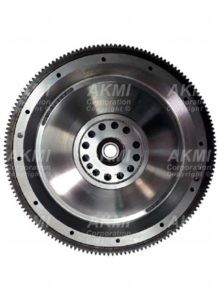Often used interchangeably, the terms flywheel and flexplate denote distinct components with different roles, especially when differentiating between manual and automatic transmissions. While both connect to the engine’s crankshaft, their function and design diverge significantly based on the type of transmission they are paired with. In the realm of automatic transmissions, the Auto Transmission Flywheel is more accurately termed a flexplate. Let’s delve into understanding what a flexplate is, how it operates within an automatic transmission, and its key differences from a traditional flywheel.
Flywheel vs. Flexplate: Key Differences
-
Transmission Type and Function:
The primary distinction lies in the type of transmission each component is designed for. Flywheels are integral to vehicles equipped with manual transmissions. Their main function is to provide a surface for the clutch assembly and to maintain engine momentum, ensuring smooth power delivery and preventing engine stalling. In a manual transmission system, the flywheel is bolted to the crankshaft, and the clutch disc is positioned between the flywheel and the pressure plate. When the driver depresses the clutch pedal, the pressure plate disengages from the clutch disc, interrupting the power flow from the engine to the transmission, allowing for gear changes. Releasing the clutch pedal re-engages the power flow in the selected gear.
Conversely, flexplates are exclusively used in vehicles with automatic transmissions. Automatic transmissions are engineered to eliminate the need for manual clutching and gear shifting, automating the gear selection process based on vehicle speed and engine load. Instead of a clutch, automatic transmissions utilize a torque converter, and this is where the flexplate comes into play. The flexplate’s role is to connect the engine’s power output to the input of the torque converter.
-
Design and Physical Characteristics:
Flywheels are robust, heavy, and thick components typically constructed from steel. Their substantial weight contributes to engine inertia, which is crucial for smooth operation, especially at lower engine speeds, and helps in engaging the clutch effectively in manual transmissions. Due to the frictional forces involved with clutch engagement, flywheels are built to withstand significant wear and tear. While durable, flywheels may require resurfacing when a clutch is replaced to ensure a smooth mating surface.
Flexplates, in stark contrast, are much thinner and significantly lighter than flywheels. This lighter design is made possible by the fluid coupling nature of the torque converter, which doesn’t rely on friction in the same way a clutch does. A key characteristic of a flexplate is its ability to flex or bend along its axis—hence the name. This flexibility accommodates slight movements and vibrations from the torque converter as rotational speeds fluctuate, reducing stress on the transmission and engine. Flexplates also feature machine-cut holes; some are for bolting to the crankshaft, while others are specific to the vehicle model and torque converter configuration, potentially aiding in weight balance. Like flywheels, flexplates also incorporate a ring gear for starter motor engagement.
Identifying a Flywheel vs. Flexplate
A simple way to determine whether your vehicle uses a flywheel or a flexplate is to consider the transmission type. If your vehicle has a clutch pedal that you must depress to shift gears, it’s equipped with a manual transmission and, consequently, a flywheel. If your vehicle is an automatic, where you simply select ‘Drive’ and accelerate, it uses a flexplate. This fundamental difference in operation dictates which component is integrated into the vehicle’s drivetrain.
Repair and Replacement Considerations
While both flywheels and flexplates are designed for durability, they can experience issues over time or due to vehicle wear and tear. Flywheels, if damaged, generally require replacement, although they can often be resurfaced during clutch replacements. The cost of replacing a flywheel can vary, depending on the vehicle model and part quality, typically ranging from around $35 to $400.
Flexplates, while less prone to wear from friction, can crack or become damaged, especially under high stress or in older vehicles. Driving with a cracked flexplate is strongly discouraged as it can be dangerous and lead to further, more costly damage to the transmission or engine. A broken flexplate often produces noticeable noises. If you suspect a damaged flexplate or flywheel, immediate inspection by a mechanic is crucial for timely repair and to prevent more severe issues.
In conclusion, while both flywheels and flexplates are crucial components connecting the engine to the transmission, they serve distinct purposes in manual and automatic vehicles, respectively. Understanding the difference, especially the function of the auto transmission flywheel (flexplate), is essential for vehicle maintenance and repair.
